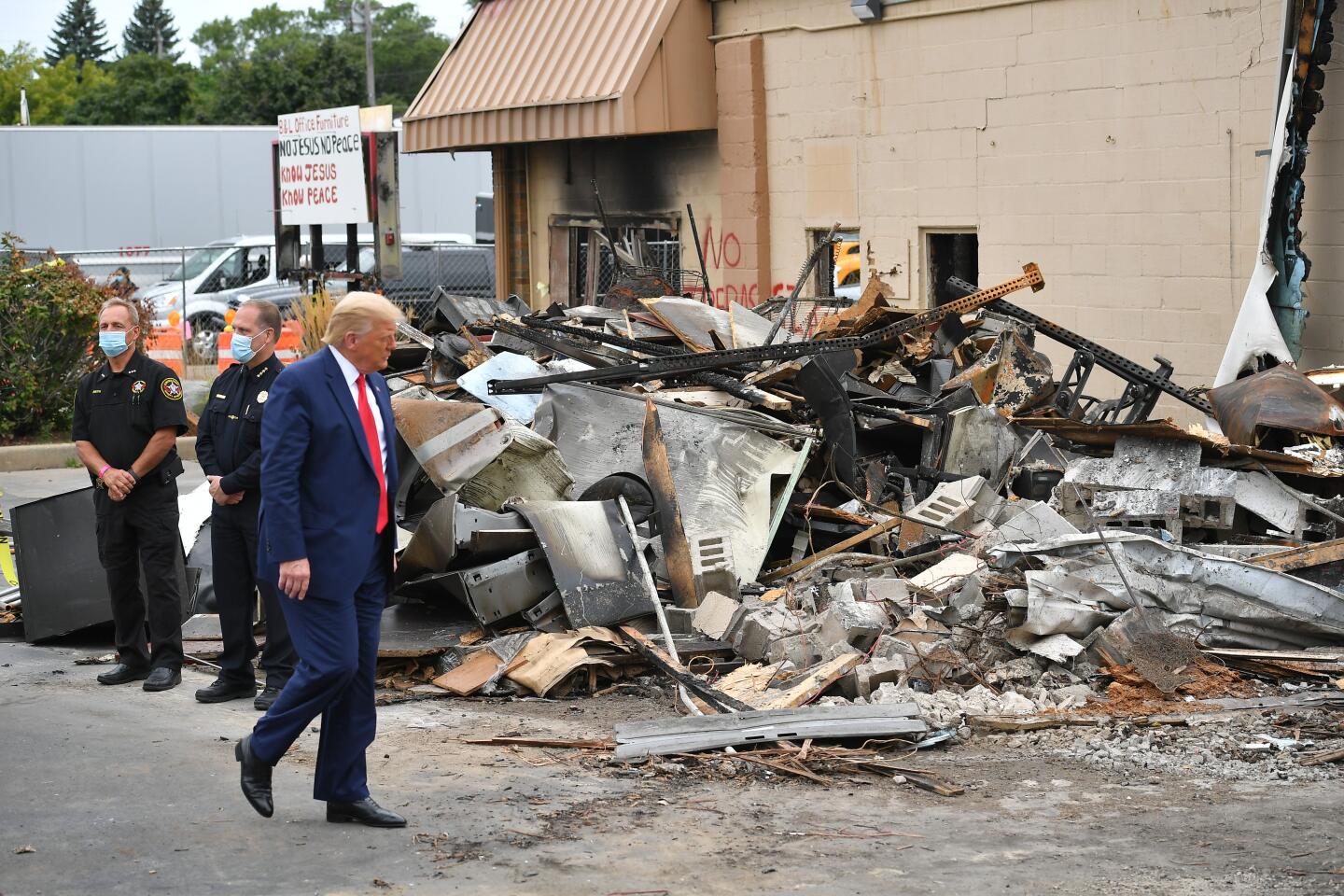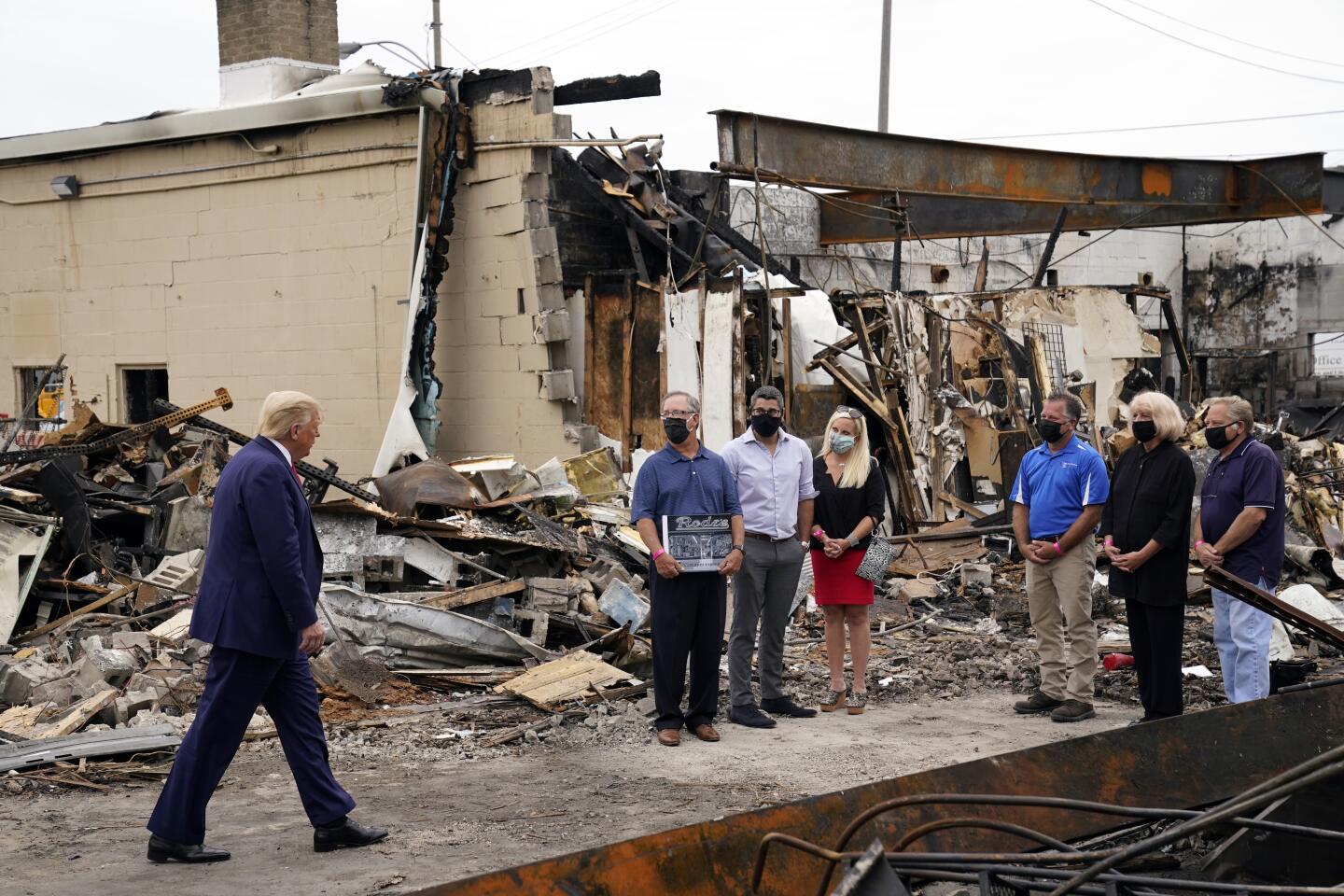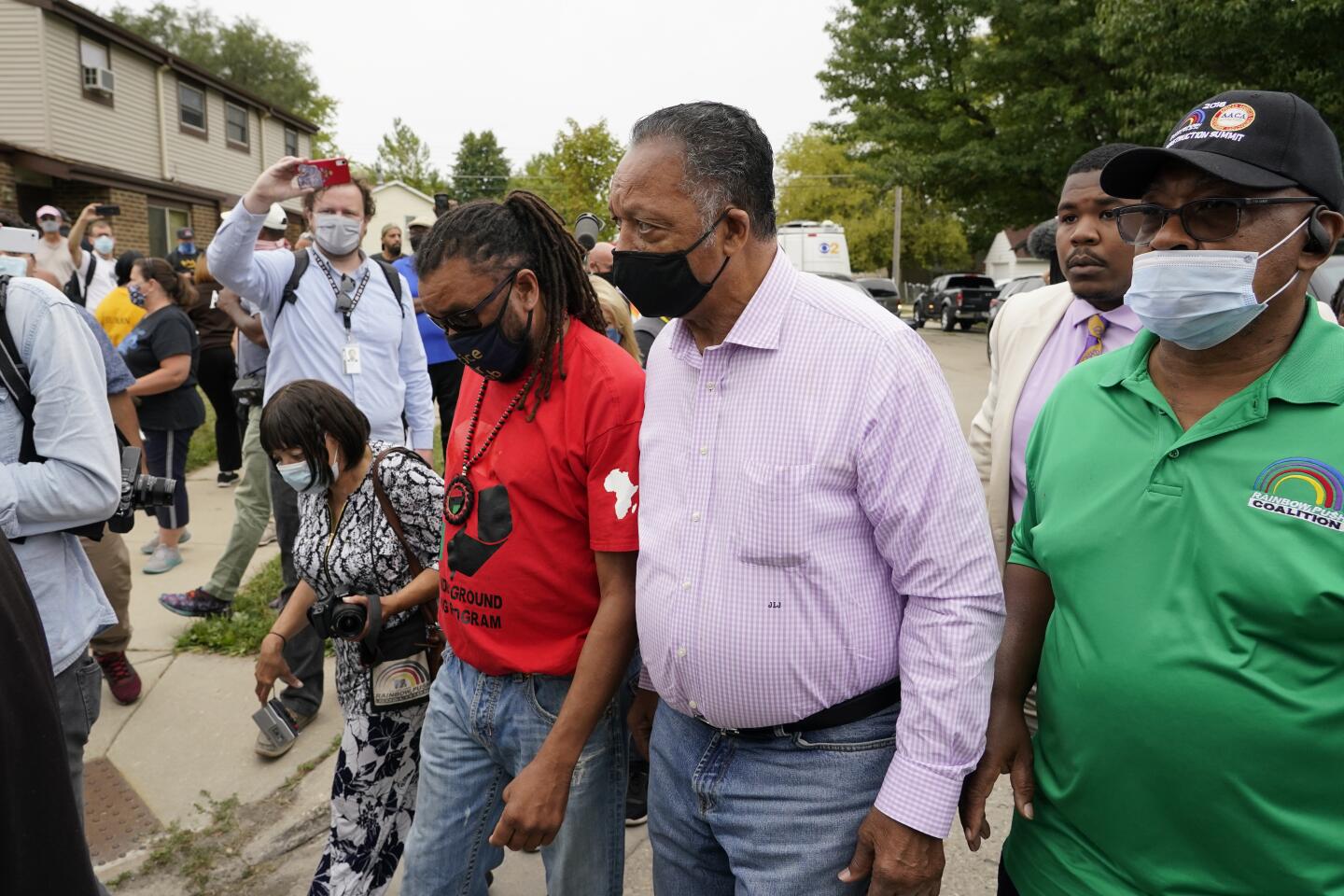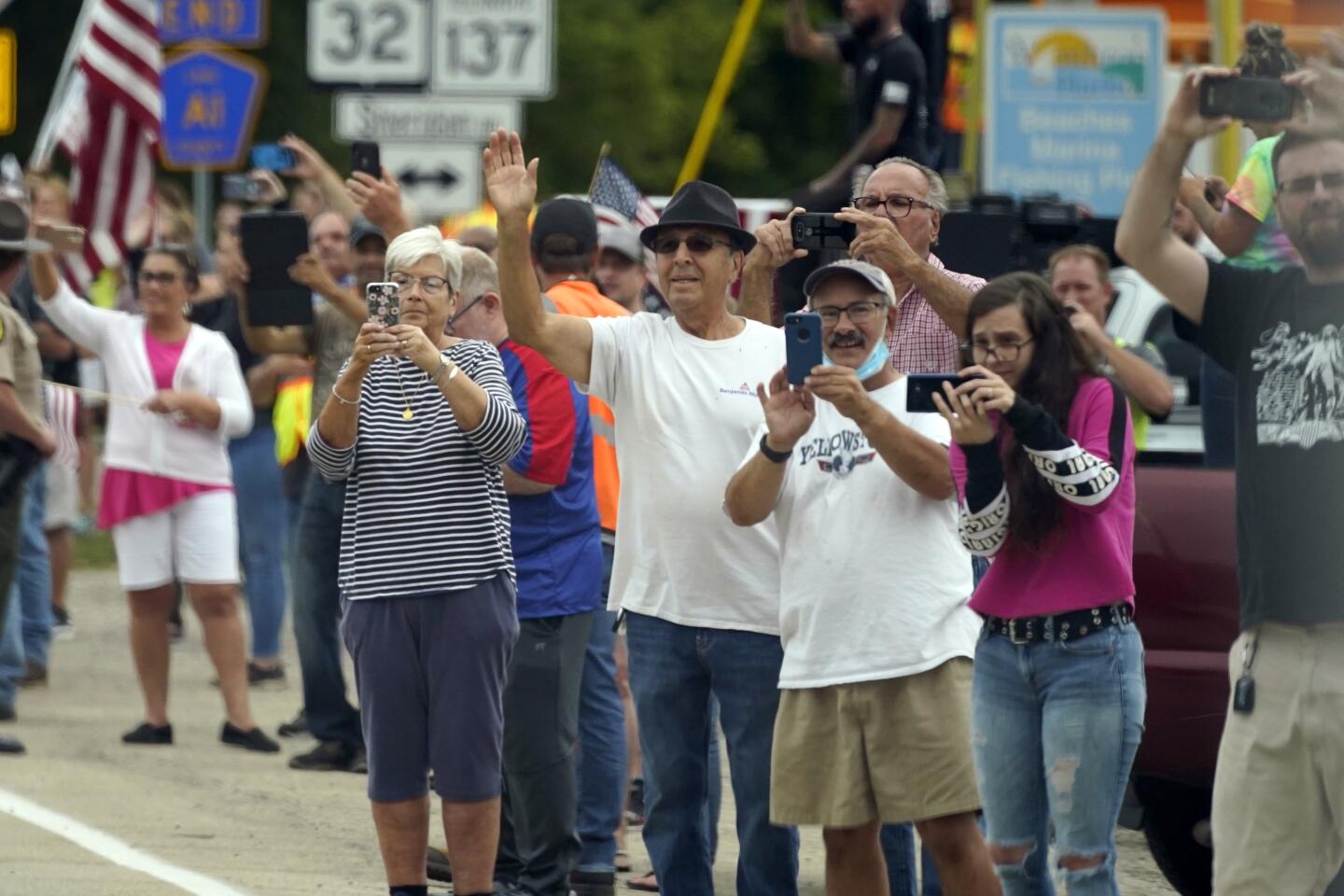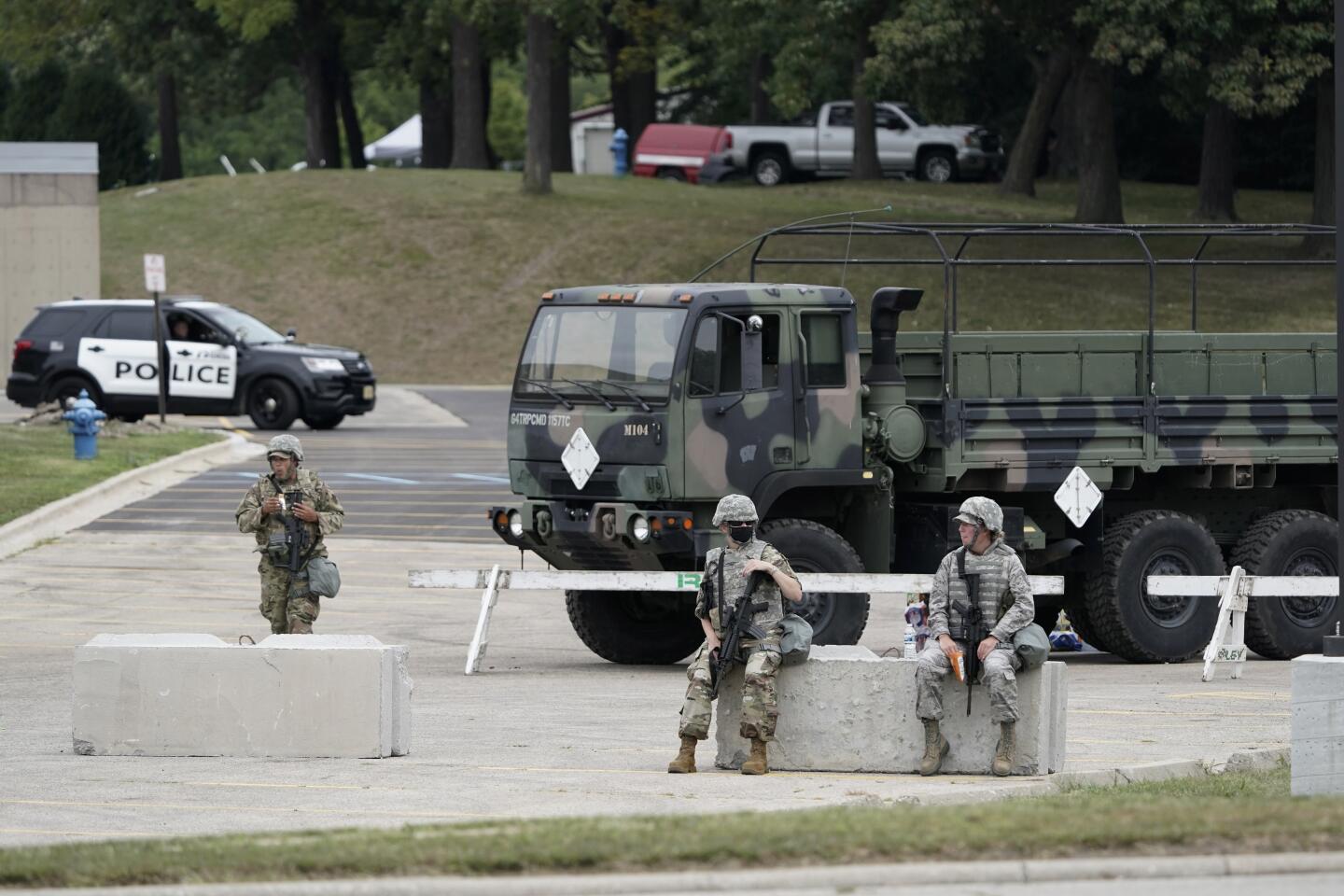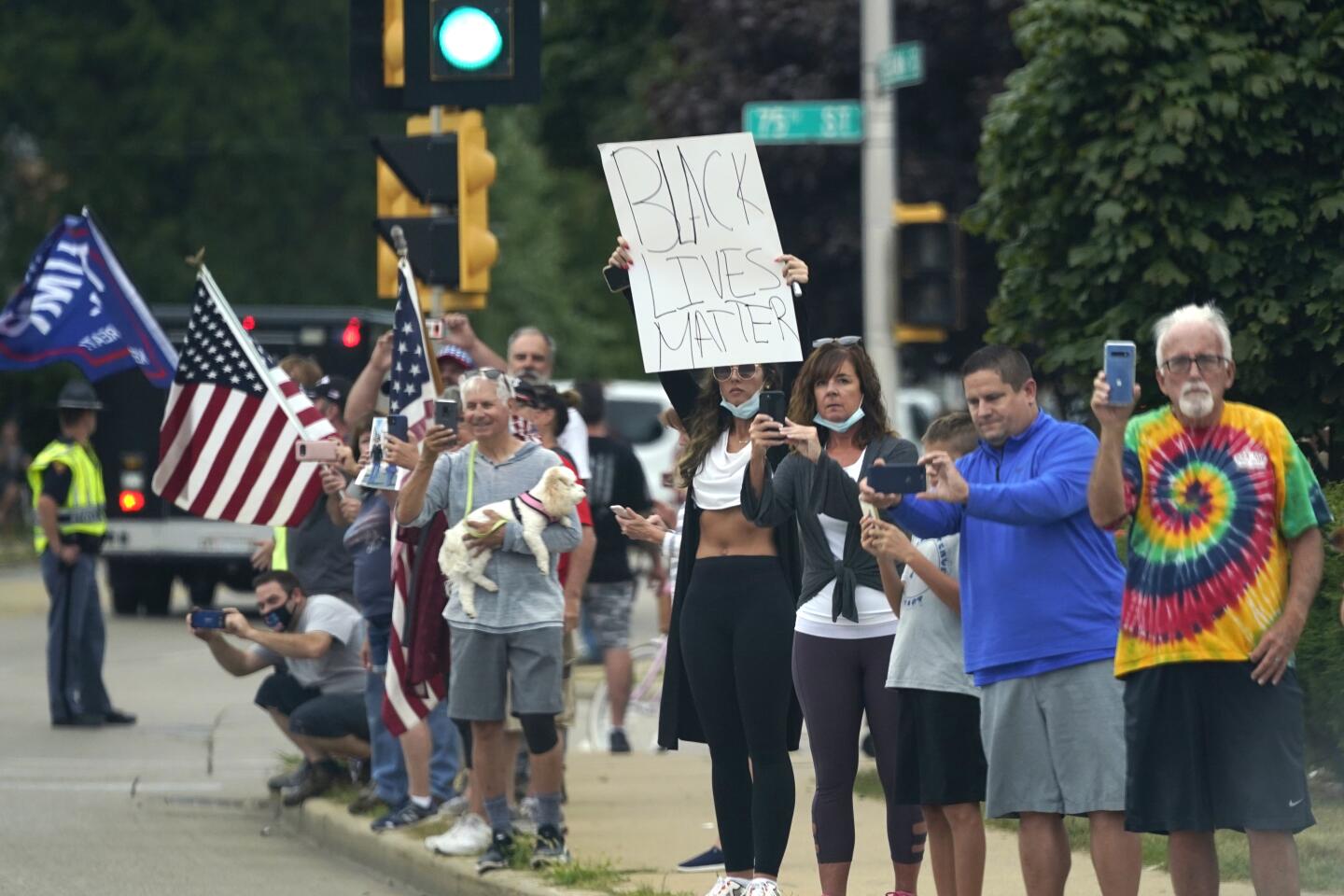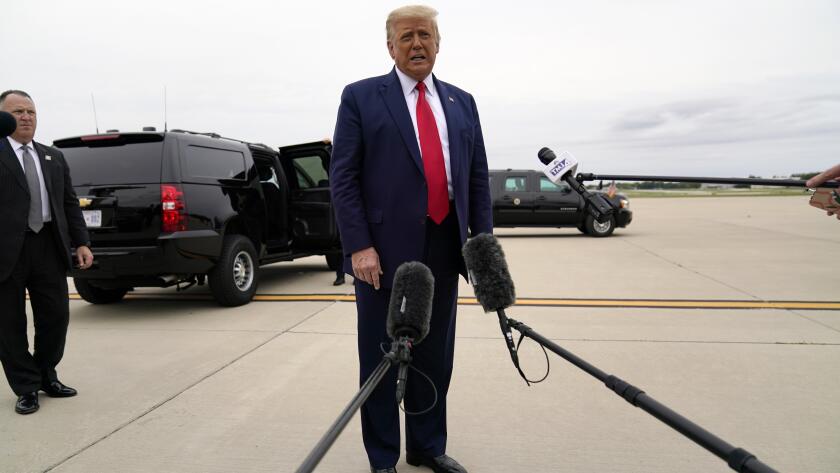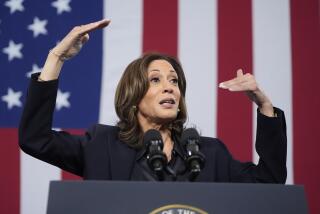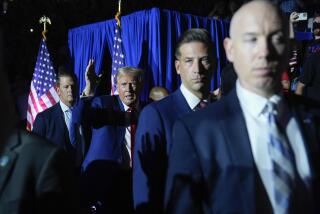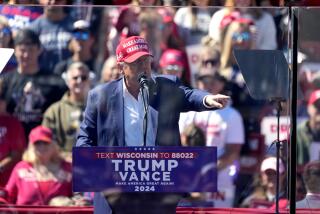Trump’s Kenosha visit exposes U.S. divisions over race and policing ahead of November vote
KENOSHA, Wis. — In front of a brick building northwest of downtown, on a day when the nation’s gaze again fixed on this once-strong factory city, Justin Blake declared that President Trump must be defeated as he stood over the spot where a police officer shot his nephew in the back seven times.
“We don’t have any words for the orange man,” Blake said of Trump as he spoke to a crowd of more than 100 people — most of them Black — who had come for a block party complete with barbecue and bounce house. “All I ask is he keep his disrespect, his foul language far away.... Our president hasn’t been a unifier.”
Two and a half miles away, a different scene unfolded in uptown Kenosha, as the president’s supporters lined up behind barricades in anticipation of his arrival, waving American flags and hoping to catch a glimpse of his motorcade.
Trump met with police, government officials and business owners to announce increased funding for law enforcement. He did not meet with the family of Jacob Blake.
Sue Wells, a 57-year-old retired cleaner and factory worker, came with her daughter and her 5-year-old grandson. She signed a petition to recall the state’s Democratic governor and disparaged the racial justice movement as she stood by the historic Danish Brotherhood Lodge, which had burned to rubble during recent protests.
“If you’re so for Black Lives Matter, why are you destroying their community?” said Wells, a white Kenosha resident. The protesters, she said, don’t “understand how it is dividing us.”
Joe Biden rejects the Republican National Convention mantra and asks: “Does anyone believe there will be less violence in America if Donald Trump is reelected?”
Trump’s visit to Kenosha on Tuesday, where he toured downtown and met with business owners, law enforcement and elected representatives, lasted all but two hours. Yet it drew out the raw passions and divides of this town — and the nation — where debates over racism, policing and protest are colliding ahead of an election many fear will only bring more rancor.
“Reckless far-left politicians continue to push the destructive message that our nation and law enforcement are oppressive or racist,” Trump said after he landed here. “They’ll throw out any word that comes to them. Actually, we should show far greater support for our law enforcement.”
Conflicting images played out across Kenosha, which like Minneapolis and Portland, Ore., before it, bore the burden of a nation’s multiplying troubles in a narrative that featured a polarizing president, parents fearful of more bloodshed and members of right-wing groups, including the Proud Boys.
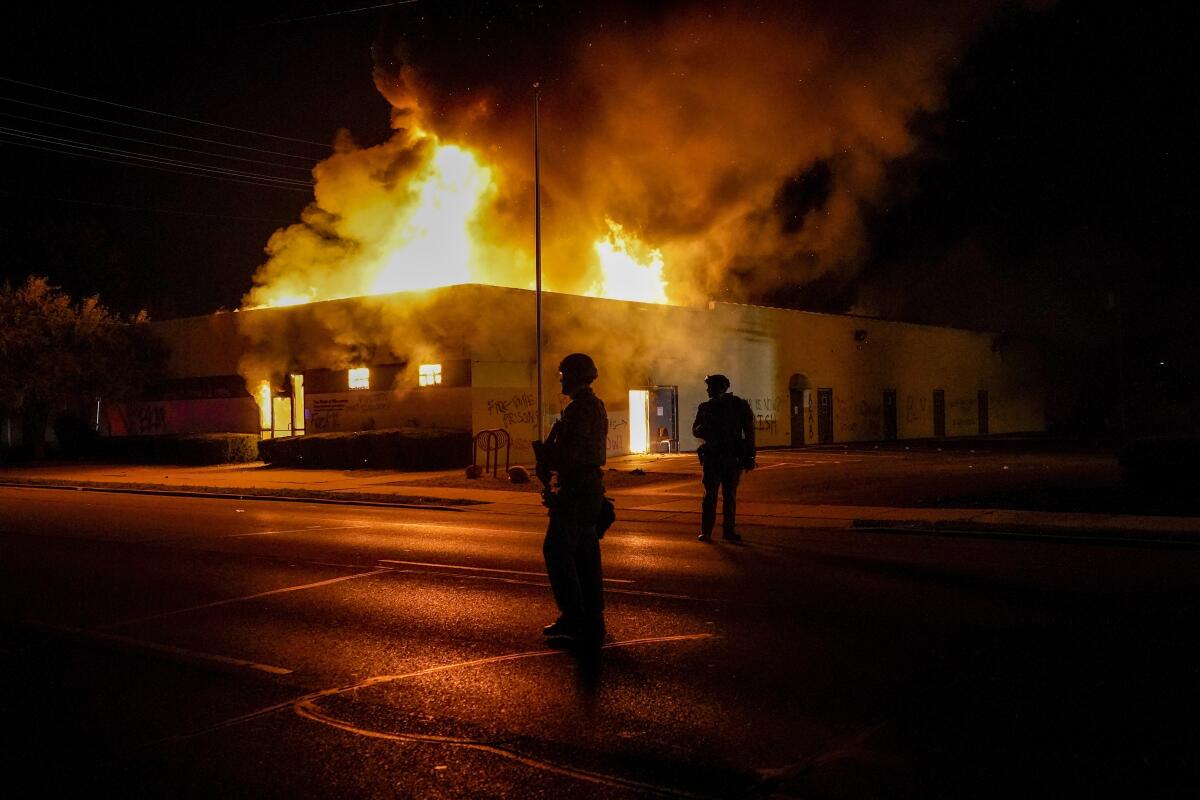
In Blake’s neighborhood, stereos blasted the “Cupid Shuffle” as groups danced in the street, some wearing shirts that said “BLAK: Black Lives Activists of Kenosha” and others calling for justice for Blake’s nephew, Jacob, who was left paralyzed. Volunteers lined up to register voters and offered free COVID-19 testing.
A few blocks northwest, dozens in red Make America Great Again hats cheered for the president’s motorcade before he spoke with local officials at Mary D. Bradford High School. Trump did not mention the Blake name, and when a reporter asked about protesters’ concerns about racism, the president said that was “the opposite subject” of what he wanted to discuss. He wanted to talk about the violence that has struck cities and left buildings torched.
“I keep hearing about peaceful protests. I hear it about everything, and then I come into an area like this, and I see the town is burned down,” Trump said. He said protests were really “acts of domestic terror” and “anti-American riots.” While much of Kenosha is on alert with boarded-up stores visible well into the suburbs, actual damage is limited to a small stretch of its urban core.
The president said he rejected a chance to speak with Jacob Blake’s mother, Julia Jackson, after learning she wanted lawyers present.
Benjamin Crump, a family lawyer, confirmed the account. “If the call had occurred, Ms. Jackson was prepared to ask President Trump to watch the video of Mr. Blake’s shooting and to do what she has asked all of America to do — examine your heart,” he said.
The police shooting of Jacob Blake and subsequent shootings in which 17-year-old Kyle Rittenhouse now faces murder charges in the deaths of two protesters have further split this crucial swing state. Trump won by a small margin four years ago in both Kenosha County and Wisconsin. Democrats hope this year that former Vice President Joe Biden will instead make gains.
Trump is pushing a “law and order” theme and is against the Black Lives Matter movement. Biden, who has spoken to the Blake family, has blamed the president for stoking violence among far-right and militia groups that have increasingly clashed with those protesting against police brutality.
Trump said Kenosha “would have been burned to the ground by now” if not for the intervention of the National Guard, which he claimed was his doing. The Wisconsin National Guard, however, has been in the city for more than a week at the request of Democratic Gov. Tony Evers, and federal law enforcement and National Guard troops from several other states joined later last week.
In a statement Tuesday, Biden called Trump’s time in Wisconsin “self-centered divisiveness accompanied by zero solutions.”
“Trump failed once again to meet the moment, refusing to utter the words that Wisconsinites and Americans across the country needed to hear today from the president: a condemnation of violence of all kinds, no matter who commits it,” a reference to Trump’s defense earlier this week of Rittenhouse, who he said was defending himself.
If plans went as some locals, including the governor, mayor and county executive had hoped, Trump would not have landed in this city of 100,000, halfway between Milwaukee and Chicago. The Democratic mayor, John Antaramian, said it would “be better had [Trump] waited.” Seven of the county’s 23 supervisors, however, wrote a letter saying they wanted the president’s “leadership in this time of crisis.”
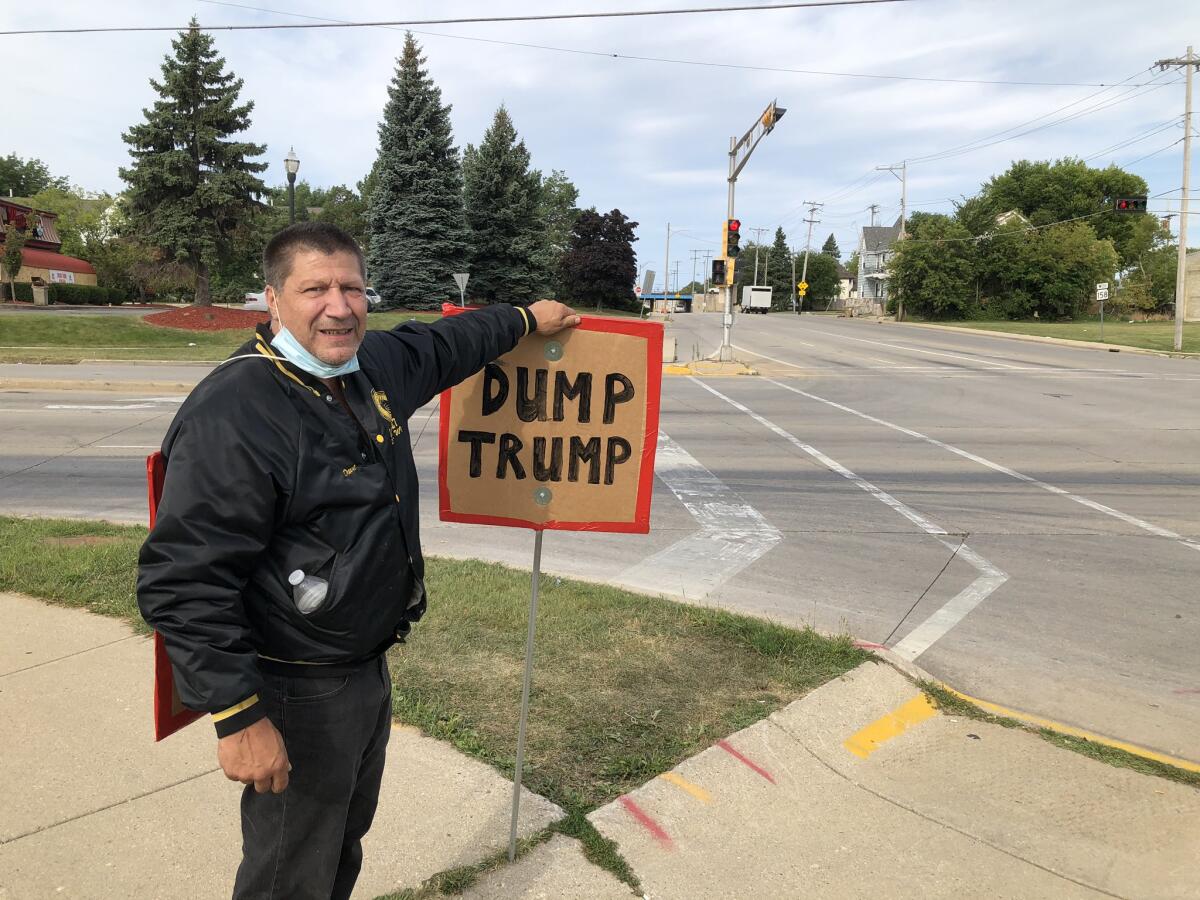
At the Danish Brotherhood Lodge, several members spent Tuesday combing the ruins for relics, including their 110-year-old registry. They were glad to hear the president was touring damaged areas of their historic neighborhood, which has undergone gentrification over the years and is now dotted with small businesses.
“He’s drawing attention to this area instead of sweeping it under the rug and saying ‘Oh, poor protesters,’” said Joe Vaughn, 58, a retired ironworker who serves as the lodge’s treasurer.
Among those scouring the wreckage were Bryan Bernhardt, 52, and his 27-year-old son. Bernhardt’s grandfather helped found the lodge, where he and Bernhardt’s late father later served as presidents. Bernhardt said he was glad to see Trump and the National Guard in Kenosha, but was worried violence would rise again.
“Minneapolis is still going through it, Seattle, Portland,” he said. “Everyone feels for the family. Does change need to be made? Probably. Let’s get all the facts first.”
A few streets away, David Swartz, 56, said he turned out to protest Trump’s use of his town as a campaign stop. Swartz, a union electrician laid off during the COVID-19 pandemic, attended recent demonstrations in support of the Black Lives Matter movement, “because nobody deserves seven bullets in the back.” But he said he has brothers in the local electricians union who support Trump.
“He’s dividing the country, dividing people, pitting them against each other,” said Swartz, wearing his IBEW Local 127 jacket as he carried his sign on a street corner.
This once industrial and union town, like much of America, is facing a reckoning after the police shooting of Jacob Blake.
Kenosha has been under curfew since last week because of protests and riots after police shot Blake, 29, on Aug. 23 after officers showed up to a northwestern neighborhood in response to a 911 call about a domestic dispute.
Rittenhouse, the teen from Illinois, is charged with two murders on the night of Aug. 25 near protest sites. Rittenhouse, who carried a semiautomatic rifle and said he was protecting local businesses, fled the scene — in plain sight of police — and was arrested the next day in Lake County, Ill. Like Trump, his lawyers said he acted in self-defense.
For Porche Bennett, a 31-year-old native Kenoshian who attended the block party on the street where police shot Jacob Blake, not enough is being done to bring police to justice.
“We want the officer charged and fired,” said Bennett, who is Black and co-founded the group Black Lives Activists of Kenosha that has helped organize recent protests. “We do not want violence. What we want is justice for Jacob Blake and his family.”
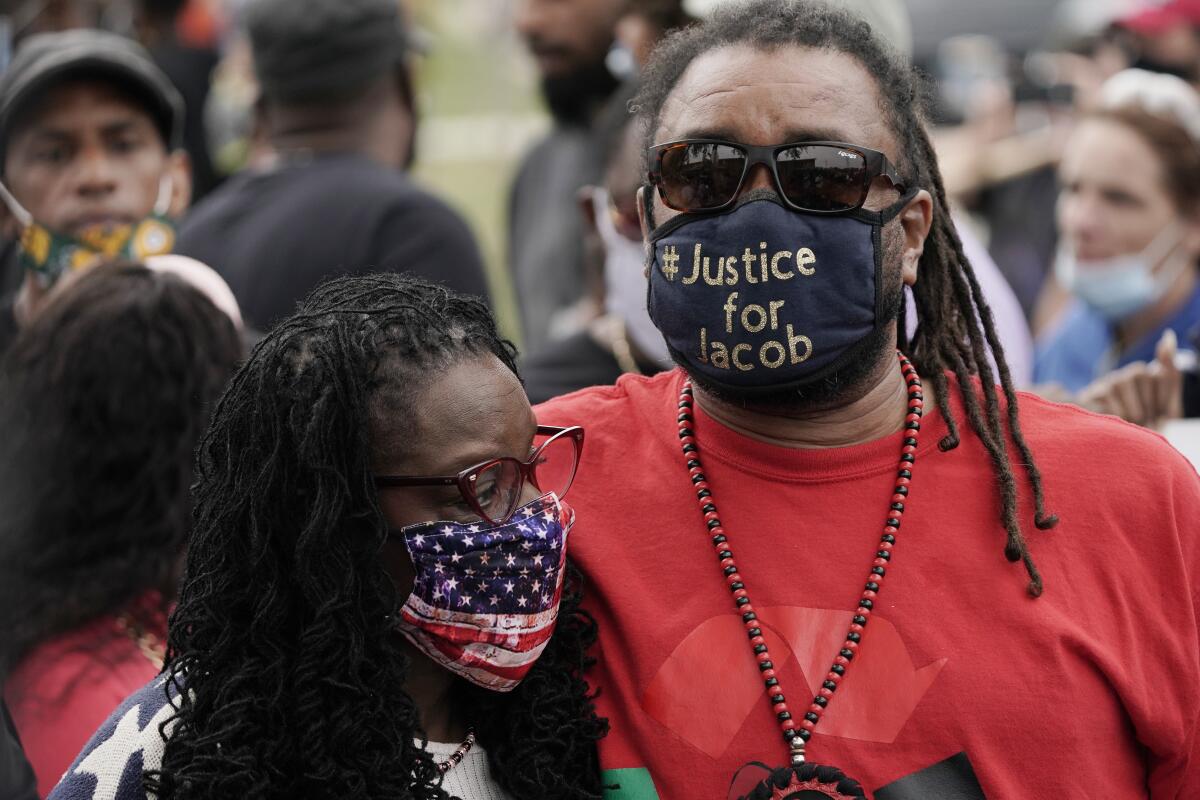
As the party wound down, a few hundred protesters marched around the Kenosha County Courthouse. National Guard troops stood watch over the fenced-in site. In this open-carry state, a handful of armed protesters, both those in support of and against the president, appeared. Small groups with members of right-wing movements, including the Proud Boys, were also present.
Protest leaders urged crowds to disperse before the 7 p.m. curfew, fearing things could quickly go wrong.
“Jacob Blake’s family really doesn’t want people out,” said KeJuan Goldsmith, 19, a University of Wisconsin-Green Bay sophomore from nearby Racine. “All it takes is one cop triggered.”
Times staff writer Eli Stokols in Washington contributed to this report.
More to Read
Sign up for Essential California
The most important California stories and recommendations in your inbox every morning.
You may occasionally receive promotional content from the Los Angeles Times.
